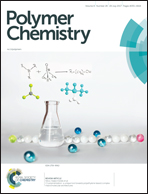PAA-g-PLA amphiphilic graft copolymer: synthesis, self-assembly, and drug loading ability†
Abstract
A well-defined amphiphilic graft copolymer comprising a hydrophilic poly(acrylic acid) (PAA) backbone and hydrophobic poly(lactic acid) side chains was synthesized by a combination of reversible addition–fragmentation chain transfer (RAFT) polymerization, ring open polymerization (ROP), and the grafting-from strategy. A well-defined PtBHBMA homopolymer having pendant hydroxyls in every repeated unit was first obtained by RAFT homopolymerization of a OH-containing tert-butyl 2-((4-hydroxybutanoyloxy)methyl)acrylate (tBHBMA) monomer. ROP of lactide was directly initiated by the pendant hydroxyls of PtBHBMA to provide a well-defined poly(tert-butyl acrylate)-g-poly(lactic acid) (PtBA-g-PLA) graft copolymer via the grafting-from strategy without post-polymerization functionality transformation. The hydrophobic PtBA backbone was selectively hydrolyzed into the hydrophilic PAA backbone so as to afford the targeted well-defined PAA-g-PLA amphiphilic graft copolymer (Mw/Mn = 1.17) having equally-distributed carboxyls along the backbone. PAA-g-PLA amphiphilic graft copolymer shows pH-responsive micellization behavior and it can self-assemble into spheres under certain conditions. Doxorubicin (DOX) can be loaded by non-toxic micelles self-assembled by the PAA-g-PLA graft copolymer and its in vitro accumulative release characteristics were investigated by fluorescence spectroscopy. In comparison with free DOX, the DOX-loading nanoparticles display decreased cytotoxicity against SMMC-7721 and SH-SY5Y cells in 48 h because of a sustained release profile of DOX.



 Please wait while we load your content...
Please wait while we load your content...